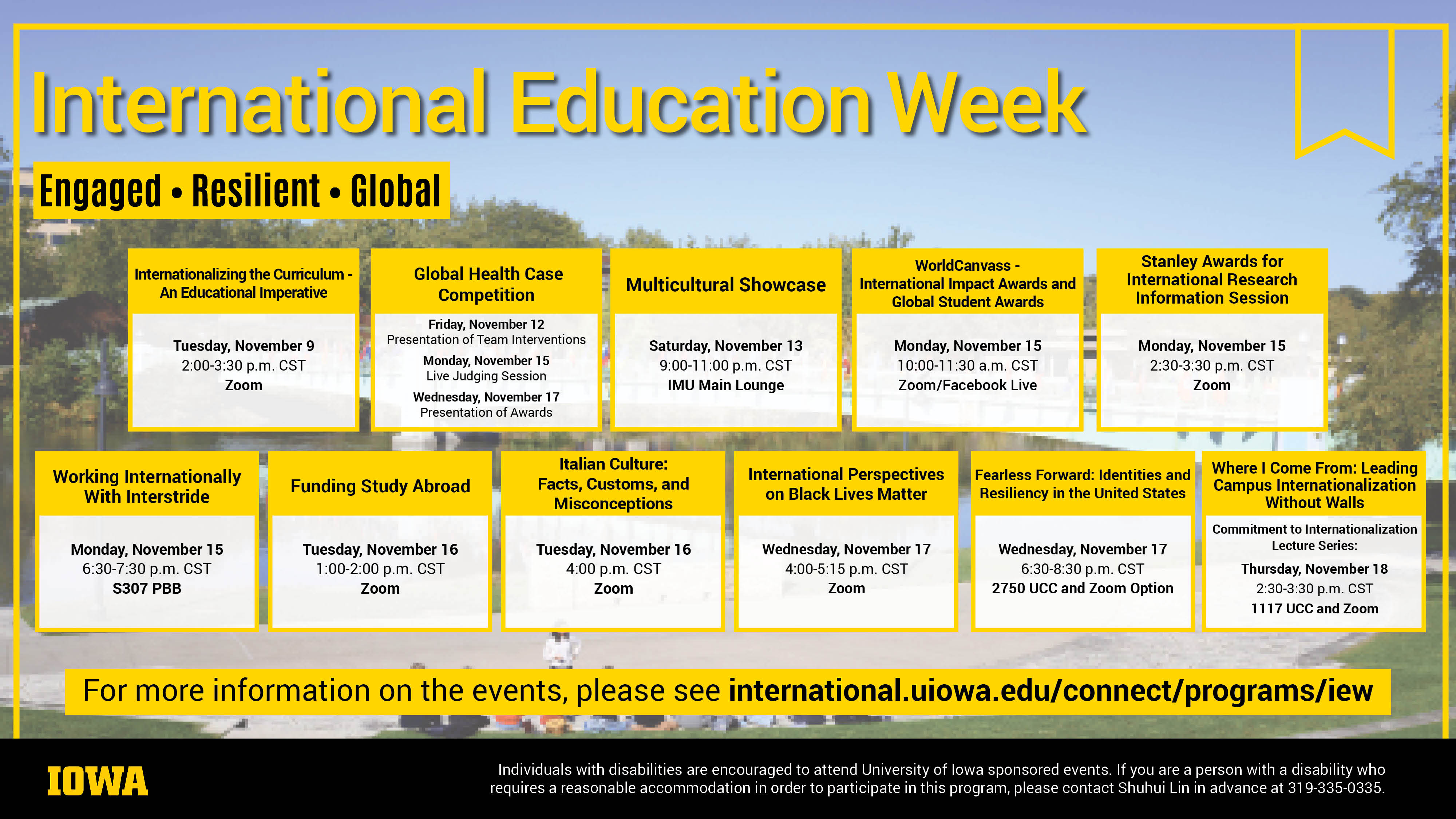Dear Students, Staff, & Faculty,
Next week, November 15-19, is International Education Week! This week is dedicated towards celebrating the benefits of international education and fostering cross-cultural relations. Thanks to technology, our world is more connected than ever, yet we still have so much to learn about each other. International Education Week allows us to both honor the achievements we've made through globalization and acknowledge the opportunities we have to continue broadening our perspectives.
This commemorative week was first celebrated in November 2000 and was established by the U.S. Department of Education and Department of State under the Clinton administration. A few months prior in April 2000, President Clinton had issued an executive memorandum declaring the federal government's support of international education, specifically committing to the following.
- Promote study abroad by U.S. students and students from other countries to study in the U.S.
- Support the exchange of teachers, scholars, and citizens at all levels of society.
- Promote study abroad by U.S. students and students from other countries to study in the U.S.
- Support the exchange of teachers, scholars, and citizens at all levels of society.
- Expand foreign-language learning and in-depth knowledge of other cultures by Americans.
- Prepare and support teachers in teaching their students about other countries & cultures
- Advance new technologies that aid the spread of knowledge throughout the world.

Open Doors is an annual census conducted by the Institute of International Education (IIE) with support from the U.S. Department of State. The census tracks both international student enrollment in the U.S. and U.S. students studying abroad. According to this census, in the 1999-2000 academic year, the U.S. hosted approximately 500,000 international students (Figure 1), and about 143,000 U.S. students studied abroad (Figure 2). In the tail end of that academic year, President Clinton issued his memorandum on international education. Fast forward to the 2019-2020 academic year, the U.S. hosted over 1 million students. The top five countries international students came from were China, India, South Korea, Saudi Arabia, and Canada.

Information on U.S. students studying abroad the same academic year won't be published until next week for the Open Doors 2021 release. However, numbers from the 2018-2019 academic year show that over 347,000 U.S. students studied abroad that year. Furthermore, an additional 38,000 students went abroad without receiving academic credit for internships, volunteering, and research. The top five regions (as classified by the IIE) that hosted U.S. students were Europe, Latin America & Caribbean, Asia, Oceania, and Sub-Saharan Africa. Overall, the total number of international students in the U.S. and number of U.S. students abroad have both doubled over time -- a testament to the federal government's efforts in supporting international education.
At the University of Iowa, our international student population has followed trends similar to the rest of the U.S. In 2000, we had 1,792 international students enrolled; in 2019, there were 3,163 international students. Similar to the statistics given by the IIE, UI's international population doubled over time.
More recently, a new trend in international education has emerged: a decrease of international students studying in the U.S. Many institutions, including our own, saw a drop in international student enrollment starting the 2016-2017 academic year. At the University of Iowa, our international enrollment decreased from 3,163 students (in 2019) to 2,176 students (in 2021). According to UI International Student and Scholar Services, several factors contribute to this decrease:
- political climate & immigration laws
- Brazil & Saudi Arabia both cut back on program funding for their students
- concerns of violence towards international students
- changes in economic stability in some countries
- difficulty obtaining visas
- increased competition from other countries
While some of these factors are out of the university's control, our community can still work to create a more inclusive environment for our international students. On campus, we have many organizations and offices who do just that. Here are a few:
ISSE works with international students and student organizations to help enrich student life outside of the classroom. Follow them on Instagram (@uiowaisse)!
ISAB advocates for international students and works with UISG, GPSG, International Programs, and the Division of Student Life to create and enact policies to improve the international student experience.
OASIS is a student organization that works to bridge the gap between international and domestic students on campus. They host multicultural events throughout the year. Follow them on Instagram (@oasis_uiowa)!
To celebrate International Education Week, several programs and organizations have collaborated to host a variety of events next week. The Office of Grad-Success and Belonging will host a student panel on Wednesday, November 17 from 6:30 - 8 PM with International Student Support & Engagement (ISSE) to discuss how international students have coped with the pandemic. Check out the schedule of events below to see other events hosted throughout International Education Week.
